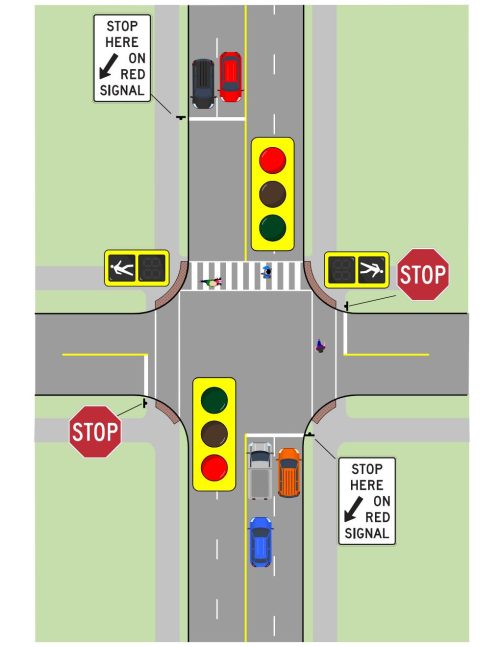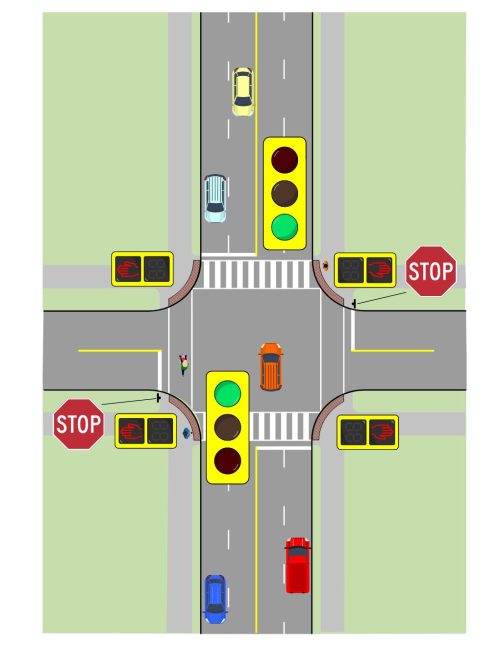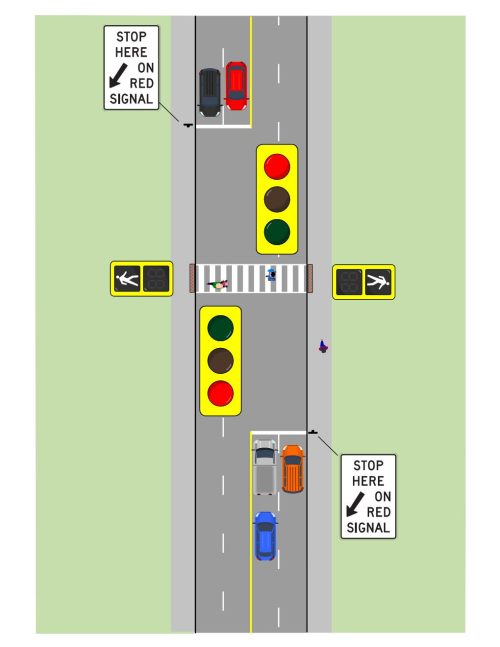
Intersection Pedestrian Signals (IPS) and Mid-Block Pedestrian Signals (MPS) offer significant advantages in enhancing pedestrian safety while optimizing traffic flow. These signal configurations allow pedestrians to safely cross busy, higher-speed main streets, either at the intersection of a side street (IPS) or at a mid-block location (MPS). Unlike Pedestrian Crossovers (PXOs), both IPS and MPS incorporate full traffic control signals and pedestrian countdown timers, ensuring clear indications for both pedestrians and people driving and cycling.
Intersection Pedestrian Signal (IPS), also known as a half signal, is a pedestrian signal configuration at intersections to improve accessibility and enhance the safety for pedestrians crossing busier streets while reducing traffic delays for people driving. IPS configurations can be installed at the intersection of a main street and a side street, where the signalized pedestrian crossing across the main street is activated by the push of a button.


Mid-Block Pedestrian Signal (MPS), is a pedestrian signal configuration between intersections to improve accessibility and help pedestrians cross main streets more safely at mid-block locations. The signalized pedestrian mid-block crossing across the main street is activated by the push of a button.

IPS and MPS differ from Pedestrian Crossovers (PXOs) where IPS configurations are intended for higher volume, higher speed main streets with lower volume side streets; and where both IPS and MPS configurations include regular traffic control signals instead of flashing beacons at PXOs. Although all three crossing types are activated by pedestrians, IPS and MPS configurations include pedestrian countdown signals to indicate when it is safe for pedestrians to cross the main street, and traffic lights on the main street for motorists to stop.
At IPS and MPS controlled crossings, pushbuttons are available for pedestrians to request a protected crossing opportunity on the main street. The traffic signal light will turn red, directing people driving on the main street to stop. Pedestrians then wait for the walk indicator from the visual pedestrian signal (and/or the audible tones from accessible pedestrian signals) before leaving the sidewalk and crossing the main street.
At IPS controlled intersections, the side streets are controlled by stop signs instead of traffic signals. People driving on side streets are to stop at the intersection and proceed to turn onto the main streets only when the intersection is clear of other vehicles and pedestrians. As there are no pedestrian signals for crossing the side street, people driving must yield to pedestrians crossing regardless of the traffic signal phase before turning onto the main street. Pedestrians are to exercise caution and be aware of vehicles turning into and/or exiting the side street before crossing.